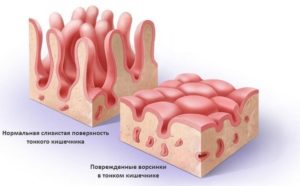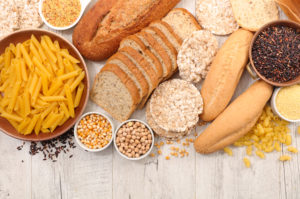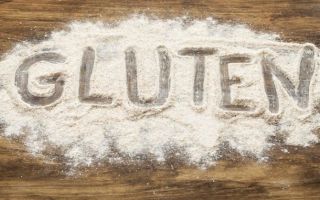Content
- 1 What is gluten
- 2 Gluten chemical composition
- 3 Why is gluten harmful to the body?
- 4 Symptoms of gluten intolerance in adults and children
- 5 Complications of gluten intolerance
- 6 Gluten Intolerance Test
- 7 Why is gluten good for you?
- 8 Where is gluten contained
- 9 Gluten Free Food List
- 10 Features of a gluten-free diet
- 11 Conclusion
Among the wide variety of food-related substances, gluten is surrounded by the most myths. The benefits and harms of gluten have been the cause of debate in the global medical community for several years now. Why are many people afraid of finding gluten in their food? For a better understanding of the problem, it is advisable to understand its useful and harmful properties.
What is gluten

Gluten, or gluten, is a complex vegetable protein that is naturally found in various cereals: wheat, barley, rye and others. In dry form, according to its physical properties, it is a white substance without taste and odor, but when combined with water it acquires a gray tint and a viscous texture. The name "gluten", which comes from the English word "glue" - "glue", describes the main beneficial property of this substance - to glue the molecules of other proteins together. Thanks to gluten, the dough gains elasticity and a characteristic viscous structure.
The unique property of gluten makes it very useful in the food industry, and not only in baked goods. It has proven to be useful as a natural thickener in sauces, confectionery, alcoholic beverages and long shelf life dairy products. The unique properties of the substance are often used by manufacturers of cosmetics and pharmaceuticals.
Gluten chemical composition
Gluten is a derivative of 2 protein compounds - glutenin and gliodin. Like any protein, it is composed of amino acids and water. It lacks vitamins, but contains micro and macro elements that benefit the body. So, the composition of gluten includes selenium, iron, phosphorus, calcium, magnesium and zinc. They have a lot of useful properties necessary for normal human functioning.
The energy value of gluten is reduced to the following indicators:
|
Gluten (100 g) |
|||
|
Calorie content |
370 Kcal |
||
|
content |
Percentage of Daily Value |
||
|
Protein |
75.2 g |
100% |
|
|
Fats |
1.9 g |
2% |
|
|
Carbohydrates |
13.8 g |
4% |
|
Gluten is a protein whose health properties are not dangerous, and in some cases even beneficial. However, people with certain medical conditions need to be careful when consuming foods that contain this substance to avoid possible harm from its effects.
Why gluten is harmful to the body
Speaking about the benefits and dangers of gluten for humans, it is important to separate the properties of the substance as such and the effect of gluten-containing products on the body. One of the many complaints about gluten is that its properties contribute to dramatic weight gain. But this is an erroneous statement. Wheat gluten is found in breads and baked goods, which are rich in well-known digestible carbohydrates and sugars. They are broken down by the body faster than fibrous protein foods, and lead to extra pounds. So this problem has little to do with the properties of gluten itself.
But there are a number of health conditions where gluten can actually be harmful to humans.
So, the properties of gluten are contraindicated in celiac disease. It is an autoimmune genetic disorder that causes the body to perceive gluten as a harmful foreign element. Cells turn on a defense reaction and begin to actively produce antibodies that destroy gluten and along the way harm internal organs. As a result, there is a deterioration in the general well-being of a person. The small intestine is most susceptible to the harmful effects of the substance. In its normal state, it is covered with special villi, which tend to absorb useful compounds from food, and then transport them into the blood. People with celiac disease have a high risk of damage to the intestinal mucosa. This affects the properties of the organ to correctly perform its functions.

Digestive disorders cause the patient to experience unpleasant sensations and can threaten the harm of various complications. According to statistics, the proportion of the population with celiac disease is 1 - 2%.
It is not recommended to consume gluten and with gluten intolerance. Although this condition is more common, in 6-10% of the population, its causes are not known for certain, and symptoms vary from case to case. Because of this, identifying gluten sensitivity can be problematic. Typically, this diagnosis is made when the patient has excluded the possibility of celiac disease and cereal allergy.
At the moment, it is impossible to completely get rid of these ailments, but there is a way to alleviate the symptoms or minimize the harmful effects, if you improve the daily menu with another healthy food that does not contain allergens.
Gluten free for children
As for the harm of gluten to children, everything is more optimistic here. Of course, children with the aforementioned diseases will not benefit from the properties of this protein. However, for those who are not at risk, the presence of gluten in the diet can be beneficial. Many gluten-containing foods are an integral part of a balanced diet, as their composition includes nutrients necessary for a child. Among them are fiber, selenium, B vitamins and amino acids, some of which are indispensable for humans and come only with food.
For a baby, the properties of gluten will also not do much harm, however, it is worth introducing the baby to complementary foods containing this protein after 8 - 9 months, after consulting a pediatrician. At the same time, it is important to pay attention to the well-being of the child and monitor any violations that arise, as they may turn out to be signs of gluten sensitivity. If no harmful influence has been identified, then you can try to diversify the baby's diet with oatmeal and semolina porridge, cookies or other delicacies made from wheat flour.
Gluten free after 40 years
Although most adults can benefit more than harm from gluten, it is worth limiting it after 40 to 50 years. Studies have shown that at this age, the body's ability to process some useful compounds, including lactose and gluten, weakens. If, after reaching this age, you do not change your eating habits, then even an absolutely healthy person will begin to feel discomfort. The best remedy in this situation is to switch to a healthy gluten-free diet.
Symptoms of gluten intolerance in adults and children
Although the symptoms of gluten intolerance vary, many are similar to those seen in celiac patients. Among adults, the following signs of illness are noted:
- irritation of the skin, itching;
- bloating and pain in the abdomen;
- chronic diarrhea;
- persistent constipation;
- flatulence;
- nausea;
- rapid fatigue, insomnia;
- joint pain;
- fragile bones.
In children, the symptoms are somewhat different:
- stunting;
- weight loss;
- frequent, frothy, loose stools with a pungent odor;
- swollen, restless stomach;
- dystrophy of the muscles of the arms and legs;
- irritability and irascibility.
Complications of gluten intolerance
If left untreated, gluten sensitivity can lead to serious harm, such as:
- Anemia. As a result of the harm caused by gluten, the intestines stop absorbing enough iron from food, which leads to its lack and the development of anemia.
- Osteoporosis. This ailment is characterized by a decrease in the strength of bone tissue.
- Hypotension. Most patients have low blood pressure.
- Gluten ataxia. This disorder disrupts the ability of muscles to move synchronously.
- Avitaminosis. Lack of nutrients entails harm to the imbalance of essential vitamins.
- Bullous polymorphic dermatitis of Duhring. This specific skin disease is characterized by profuse eruptions and severe itching.
- In especially difficult cases, this is fraught with harm to the oncology of the gastrointestinal tract.
Timely refusal of gluten-containing products will help to avoid such complications.
Gluten Intolerance Test
The most reliable way to determine gluten sensitivity is through specialized medical tests. However, you can try to identify the possible harm of this ailment at home. To do this, it is worth excluding food and drinks with wheat gluten from the menu for a period of 2 weeks to 1 month, listening to any changes in the body that occur during this time. After the specified period, you should return to "dangerous" food. If at the beginning of the experiment a significant improvement in well-being was recorded, and after returning to the previous eating habits, an immediate deterioration followed, then it is highly likely that the patient suffers from gluten intolerance. And yet, the result of such a test can only be checked and confirmed by a specialist.
Why is gluten good for you?
Despite its notorious reputation, wheat protein has benefits as well as harm. So, gluten is a building material of the body, which is useful in the formation of muscles and internal organs, in the work of the circulatory system and the normalization of the chemical processes of the human body. Amino acids in gluten also play an important role, since they tend to regulate the work of all internal systems. Thus, methiosine synthesizes red blood cells, lysine has beneficial bactericidal properties, and threonine supports the functions of the digestive system. In addition, gluten contains selenium, which is important for the nervous system, as well as iron, fiber, and more than half of the daily requirement of phosphorus, the useful properties of which affect the efficiency of the brain.
Where is gluten contained

If, for medical reasons, gluten must be avoided, it is important to find out where it is stored. However, even with a careful study of the properties of the composition of the product, it is not always possible to accurately determine the presence of gluten in it that does not threaten harm. Often on labels, the following names are used to designate it:
- modified food starch;
- hydrolyzed protein;
- textured vegetable protein.
As a rule, gluten-free products are labeled accordingly. From time to time there are also English variants of labeling - "no gluten" or "gluten-free".
Products containing gluten
Gluten is included in the following products:
- cereals (wheat, rye, barley, oats);
- dough and flour from these cereals, and flour products (bread, pancakes, cakes, rolls, pies, muffins, cookies, pizza, pasta);
- semi-finished meat and fish products (cutlets, sausages, sausages, crab sticks);
- Soy meat;
- ready-made spices and soups;
- dairy products (some cheeses, cottage cheese desserts, yoghurts, condensed milk);
- sauces and dressings, mayonnaise, ketchup;
- muesli and cereals;
- ice cream and sweets (Turkish delight, halva, marshmallow, sweets, chewing gum);
- crackers, chips, croutons.
- coated drugs.
Gluten Free Drinks
Gluten is also found in some beverages, such as:
- beer;
- low-alcohol drinks and factory-made cocktails;
- kvass;
- colored carbonated drinks;
- drinking yoghurts with cereals or dyes;
- undistilled vodka.
Nutritional supplements
Because gluten is well established as a natural preservative, its benefits are often used to enhance flavor and extend shelf life with the following additives:
- E106;
- sugar color and its variations (E150);
- E411;
- E 471;
- maltol (E 636);
- ethyl maltol (E637);
- isomaltol (E953);
- maltitol (E 965).
Gluten Free Food List

Although the list of names of products containing dangerous possible harm wheat gluten is quite extensive, nevertheless, there are also many useful foods without this ingredient in the composition.
The benefits of gluten-free foods have long been known as they all form the basis of a healthy diet. These include:
- any meat;
- fish and other seafood;
- buckwheat, corn, rice, quinoa, sorghum, millet;
- buckwheat, corn, potato, coconut, almond and hemp flour;
- potatoes;
- soy, tapioca, flaxseed;
- any vegetables;
- beans, peas, beans;
- all types of fruits and berries;
- any unprocessed nuts and seeds;
- natural dairy products without additives;
- eggs;
- mushrooms;
- Tea coffee;
- natural juices;
- baby milk formula.
Features of a gluten-free diet
Around the world, more and more people refuse gluten, which is dangerous for its "harm", among whom there are many of those whose body is quite capable of processing it. It's easy to get carried away with the pursuit of health, and then a gluten-free diet will not be beneficial, but harmful. Therefore, when switching to this diet, you should remember:
- A number of products labeled "gluten-free" contain more fat, sugar and carbohydrates and less healthy fiber than their "harmful" counterparts, therefore, the feeling of fullness from them passes faster. Abuse of such food leads to the harm of a rapid increase in body weight, and the benefits of such a diet will quickly disappear.
- A diet consisting mostly of healthy, easily digestible carbohydrates can provoke harm from a fungal infection - candidiasis. Therefore, before starting the diet, it will not be superfluous to undergo a course of preventive treatment for this ailment.
- The absence of cereals in the menu deprives a person of many compounds and trace elements that are useful for their properties. And this, in turn, causes harm to vitamin deficiency and iron deficiency, and therefore it is necessary to increase the proportion of vegetables, eggs and fish in the menu.
In addition, adhering to all the requirements of a gluten-free diet can be very costly. Therefore, those who set themselves the goal of adding healthy nutrition to the menu are advised to reduce their gluten intake without completely abandoning it.
Conclusion
Despite numerous studies, the benefits and harms of gluten are not well understood to this day. But although the properties of this protein are controversial, it is reliably known that its harm to a healthy person is greatly exaggerated. Sick people should be more careful about their diet and exclude or limit the use of this substance.

